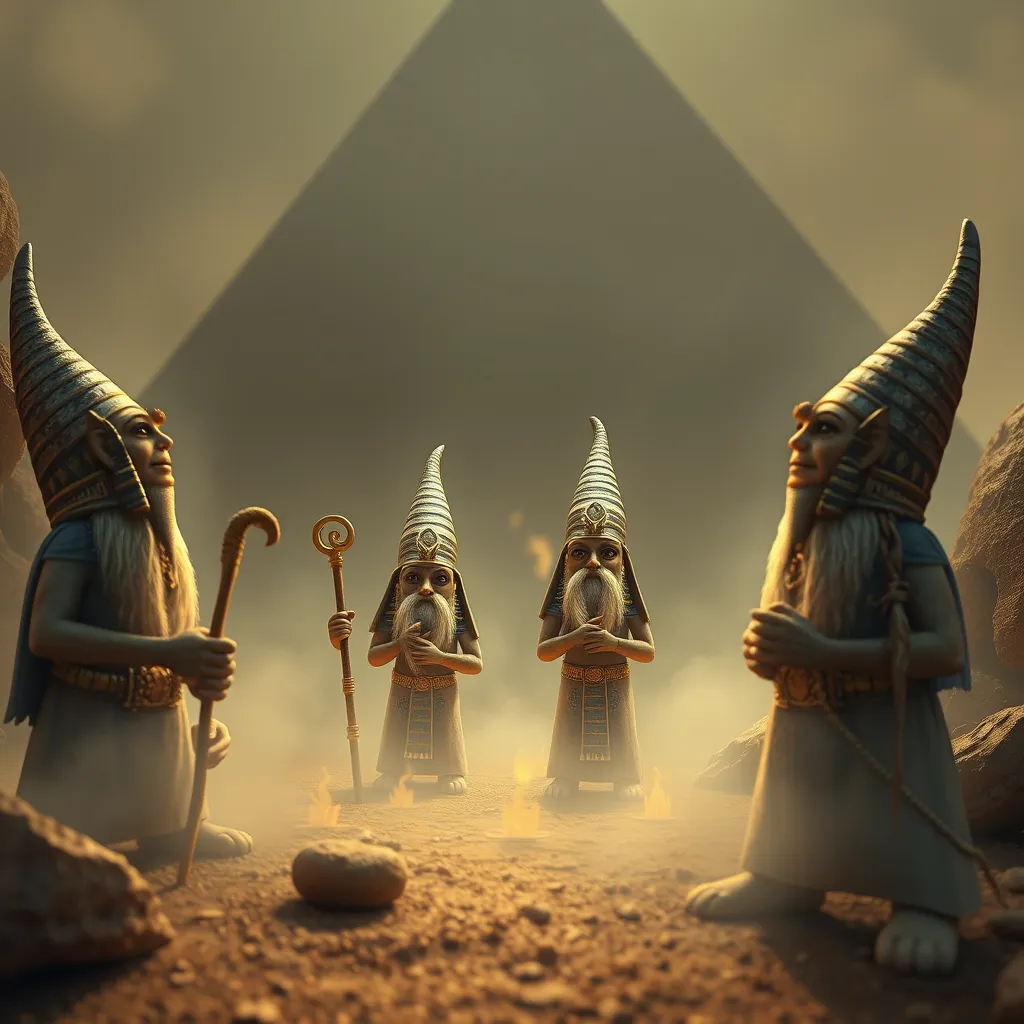Egyptian Gnomes: The Hapi and the Spirits of the Nile
I. Introduction to Egyptian Gnomes
In the rich tapestry of Egyptian mythology, gnomes are often viewed as nature spirits or divine guardians of specific aspects of life. These entities are not gnomes in the traditional sense but represent the embodiment of natural forces and the mysteries of the land. One of the most significant figures in this realm is Hapi, the god of the annual flooding of the Nile River, which was central to Egyptian agriculture and prosperity.
The Nile River, often referred to as the lifeblood of Egypt, was revered for its vital role in sustaining the civilization. Hapi, as the personification of the Nile’s flooding, symbolizes fertility, abundance, and the generous gifts of nature, making him a crucial figure in the ancient Egyptian pantheon.
II. The Role of Hapi in Ancient Egypt
A. Characteristics and appearance of Hapi
Hapi is typically depicted as a robust man with a large belly, symbolizing abundance and fertility. His skin is often shown as green or blue, representing the lushness of the land that the Nile nourishes. He is usually portrayed with the traditional symbols of abundance, such as a necklace of large fish and the papyrus plant, which signifies the life-giving properties of the river.
B. Symbolism of Hapi in relation to fertility and abundance
Hapi’s significance in ancient Egypt extends beyond mere representation; he was integral to the agricultural cycle. The annual flooding of the Nile, which occurred around June, brought nutrient-rich silt to the land, making it fertile for planting. The Egyptians believed that Hapi was responsible for this life-giving flood, and as such, he became synonymous with fertility, prosperity, and sustenance.
III. The Nile River: Lifeblood of Ancient Egypt
A. Geographic and historical significance of the Nile
The Nile River is the longest river in the world, stretching over 4,000 miles and flowing through eleven countries. In Egypt, it runs northward through the desert, creating a narrow strip of fertile land along its banks. This unique geography allowed ancient Egyptians to thrive in an otherwise arid environment, making the Nile indispensable to their survival and development.
B. The Nile’s influence on agriculture and civilization in Egypt
The Nile’s annual flooding deposited rich silt on the surrounding land, enabling the cultivation of crops such as wheat, barley, and flax. This agricultural bounty supported the growth of one of the world’s earliest and most sophisticated civilizations. The Egyptians developed advanced irrigation techniques, which allowed them to harness the river’s resources effectively.
As a result, the Nile not only shaped the physical landscape but also influenced social, political, and economic structures in ancient Egypt.
IV. The Spiritual Realm of the Nile
A. The concept of spirits associated with the Nile
In addition to Hapi, the Nile was believed to be inhabited by various spirits that influenced the natural and spiritual world. These spirits were seen as guardians of the river, each with specific roles and attributes that reflected the duality of nature.
B. Types of spirits: benevolent and malevolent
- Benevolent spirits: These spirits were thought to bring good fortune, fertility, and protection to the people and their crops. They were often appeased through rituals and offerings.
- Malevolent spirits: Conversely, some spirits were believed to cause floods, droughts, or misfortunes. The Egyptians sought to ward off these negative influences through protective charms and rituals.
V. Rituals and Worship of Hapi and Nile Spirits
A. Festivals and ceremonies dedicated to Hapi
The Egyptians held numerous festivals in honor of Hapi, particularly during the inundation season. These celebrations included music, dance, and offerings to the god, expressing gratitude for the blessings of abundance. One of the most important festivals was the Wepet-Renpet, which marked the beginning of the agricultural year.
B. Offerings and practices to appease the spirits of the Nile
To ensure the favor of Hapi and the spirits of the Nile, the Egyptians practiced various rituals, including:
- Offering food, flowers, and incense at sacred sites along the Nile.
- Creating altars and shrines dedicated to Hapi and local river spirits.
- Performing prayers and chants to invoke blessings for the coming harvest.
VI. Hapi in Art and Culture
A. Depictions of Hapi in ancient Egyptian art
Hapi’s image can be found in countless artifacts, including temple reliefs, sculptures, and pottery. Artists portrayed him with attributes that emphasized his connection to fertility, such as the overflowing harvest and the abundance of the Nile’s bounty. These depictions served both religious and decorative purposes, reinforcing the importance of Hapi in daily life.
B. Influence of Hapi and Nile spirits on literature and folklore
Hapi and the spirits of the Nile also played a significant role in Egyptian literature and folklore. Stories and myths centered around these figures often illustrated moral lessons or offered explanations for natural phenomena. They became integral to the cultural identity of the ancient Egyptians, echoing through generations.
VII. Modern Interpretations of Hapi and Egyptian Gnomes
A. Contemporary representations in popular culture
In modern times, Hapi and Egyptian gnomes have found their way into various forms of popular culture, including literature, film, and art. They are often portrayed as whimsical figures, embodying the magical aspects of ancient Egyptian mythology.
B. The revival of interest in ancient Egyptian spirituality
There has been a resurgence of interest in ancient Egyptian spirituality and mythology, with many people exploring the teachings and beliefs surrounding figures like Hapi. This revival is reflected in new age practices, art, and literature that draw on the rich symbolism and wisdom of ancient Egypt.
VIII. Conclusion
A. The enduring legacy of Hapi and the spirits of the Nile
The legacy of Hapi and the spirits of the Nile continues to resonate in today’s world. They symbolize the deep connection between humanity and nature, reminding us of the importance of respecting and honoring the natural world that sustains us.
B. Reflection on their significance in understanding ancient Egyptian culture
Understanding Hapi and the spirits of the Nile provides valuable insights into the beliefs, values, and practices of ancient Egyptians. Their reverence for these figures reflects a profound appreciation for the cycles of life and the gifts of nature, elements that remain relevant in our contemporary ecological consciousness.



